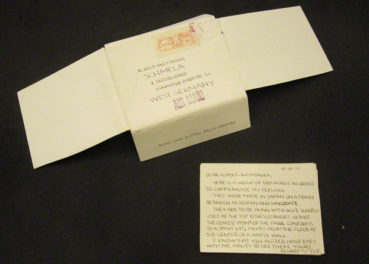In Renaissance and early modern Europe, festivals were the stage for food in amazing forms. Celebrations featured banquets with dozens of courses, 100-foot-long tables bearing monumental sugar sculptures, choreographed feasting in the streets, and even architectural monuments festooned with edibles. This food is long gone, but the stories remain in centuries-old prints and rare books.
 This is the tale told in The Edible Monument: The Art of Food for Festivals, an exhibition curated by chief curator Marcia Reed at the Getty Research Institute from the Institute’s Festival Collections. I spoke to Marcia during the installation of the intricate sugar sculpture that dominates the exhibition’s main gallery.
This is the tale told in The Edible Monument: The Art of Food for Festivals, an exhibition curated by chief curator Marcia Reed at the Getty Research Institute from the Institute’s Festival Collections. I spoke to Marcia during the installation of the intricate sugar sculpture that dominates the exhibition’s main gallery.
What is The Edible Monument about?
It’s about the importance of food to celebrations.
The show mostly features works on paper, prints and books recording festivals that took place centuries ago. I also wanted to show other elements, like a real sugar sculpture, silver table pieces, and the food that was actually on the table to eat.
We also go behind the scenes to show the people who worked for the festivals–the cooks, the confectioners, the carvers, the pastry cooks–and some of their tools, methods, and materials.
Tell us about the sugar sculpture at the center of the exhibition.
Ivan Day, a culinary historian who is the rock star of his field, has built for us the Temple of Circe in sugar. Gluttonous men have come to visit her on her island, and she’s in the process of turning them into pigs. The men-pigs on the bottom are running away as they realize that they’re being transformed because of their greed and their gluttony.

Marcia Reed and Ivan Day installing the sugar sculpture in The Edible Monument
Why did you commission the sugar sculpture?
The sugar sculptures are a way in for people to understand the prints, the rare books, and the descriptions of the banquets in the exhibition.
It’s hard to imagine these huge halls with their teeming crowds, and the table service done over periods of many hours. Some people were allowed to sit at the table and to eat, but many others were only allowed to come in and view the ceremonies, the celebrations, and the banqueting–and when those were done, they were probably pretty hungry too, and they got the leftovers.
In festival descriptions, they didn’t really mention food very much, and they certainly didn’t tell you very much about what was actually offered or eaten. But food was probably a very, very important part of festivals. Just think of Thanksgiving, Christmas, Easter, and even family holidays.
What’s the symbolism of sugar?
Sugar is so complicated. It means so many things to different people. Some people think it’s a special ending to a meal or a wonderful snack; other people know the history of sugar cultivation and slavery and have a very negative association with sugar. In the late Middle Ages and Renaissance, sugar was associated with enormous expense and conspicuous display. If people had a lot of sugar, it meant that they were very, very wealthy. That was why they made sugar pieces for these banquets.
What will happen to Ivan’s sculpture after the show?
Everyone is asking this question! Maybe it will travel with the exhibition. I think we’ll look at its condition and see what we want to do with it. Sugar does, after a while, fall apart. Will it be time to just put it to bed? RIP sugar sculpture? I don’t know.

Marcia with the opening wall mural in The Edible Monument
What’s your favorite sweet treat?
I like to make desserts. For the people installing the exhibition I made Chinese almond cookies, and everybody’s chomping away on them here. But my favorite? Maybe sorbet.
What do you hope people take away from the exhibition?
When they leave, I think they’ll be pretty hungry.
_______
#ArtofFood is a series about food in art in medieval, Renaissance, and early modern Europe. It complements the exhibitions The Edible Monument: The Art of Food for Festivals at the Getty Research Institute and Eat, Drink, and Be Merry: Food in the Middle Ages and Renaissance at the Getty Museum. Visit the Getty Center to explore both exhibitions via the Art of Food mobile tour.




Comments on this post are now closed.